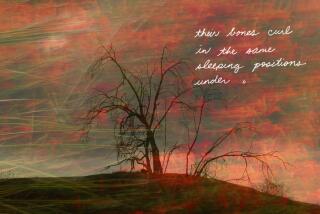A History of Modern Poetry: MODERNISM AND AFTER by David Perkins (Belknap/Harvard: $25; 659 pp.)
- Share via
Volume I of David Perkins’ ambitious history of 20th-Century British and American poetry appeared in 1976; it took us from the 1890s, when the seeds of the Modernist movement were sown, to the mid-1920s oS. Eliot’s “Waste Land” and W. B. Yeats’ “Sailing to Byzantium.” Now, 11 years later, here is the Harvard professor’s second volume, which picks up the narrative at the moment when Eliot is enshrined as the Great Poet and brings us, via many Modernist twists and Postmodernist turns, to the present of John Ashbery and James Merrill, whom Perkins takes to be the two “finest living American poets.”
From Eliot to Ashbery and Merrill, by way of Ezra Pound, William Carlos Williams and Wallace Stevens: This, in a nutshell, is Perkins’ map of our 20th-Century poetry. “The Age of High Modernism” (the title of Part I), which is to say, the age of the later Eliot, the early W. H. Auden, Hart Crane and their various followers, is transformed by “The Resurgence of Pound, Williams and Stevens” (Part II) into the “Postmodernism” of Part III. It is Pound, Williams and Stevens, so Perkins argues, who stand behind the new “period style” of the late ‘50s and ‘60s, a style that is described as being “spontaneous, personal, naturalistic, open in form and antagonistic to the idea of form, intellectually skeptical yet morally concerned.” It ranges from the “direct emotion, versification by breath, agrammatical syntax (and) unplanned development” of Allen Ginsberg’s “Howl” to John Ashbery’s deployment of “a continual expectation of form that is constantly frustrated.” At the same time, as Perkins is careful to point out, many significant poets today, most notably in Britain, have no truck with this “open form” poetics.
Indeed, and this is the irony, Perkins has little taste for it himself. Try as he may to be fair-minded about what he calls “postmodernism,” his own bias is clearly toward the very “New Critical,” “Eliotic,” and formalist poetry he describes as having been superseded by the Postmodernists. This bias is evident in the book’s organization: What purports to be a “history” is more accurately a chronologically arranged series of readings of specific texts by individual poets, readings that focus on such issues as the given poem’s coherence, complexity, arrangement of images and unity.
Thus, Perkins seems to be more comfortable with, say, Louis MacNeice’s “The Sunlight on the Garden” or Seamus Heaney’s “Anahorish” than he is with Pound’s “Cantos” or the spare literalist lyric of Williams. “Though there is much to be said,” he writes of the “Cantos,” “for ideograms as a method of presentation, ideogramic thinking, as the poem exemplifies it, is undisciplined and self-indulgent.” As for Williams, “Do we now, sixty years later, take much interest . . . in Williams’ talky, minimal lines?” And of Wallace Stevens’ “The Plain Sense of Things,” we read, “Few readers would call this a ‘great’ poem, for it lacks the magic of phrase, the intensity and drama of emotion, the depth of connotation and profundity of symbolism that are now associated with this adjective.”
Intensity and drama of emotion, depth of connotation, profundity of symbolism--here are the criteria par excellence of the ahistorical New Criticism of mid-century, criteria that make the whole project of writing a large-scale history of modern poetry problematic, to say the least. For, if poems are regarded as so many discrete entities, groupable at best only loosely according to this or that category (e.g. “Confessional,” “New York and San Francisco,” “Against Civilization”) but not intrinsically accountable to the culture that has produced them or to the conventions that govern their production, where is the line of historical narrative that could connect the “High Modernism” of Eliot to, say, the “Romantic revival” of Dylan Thomas? Or, conversely, how has a largely shared history had two such different outcomes in postwar British poetry and its American counterpart?
To address such questions is to take a position on the nature and role of historical change, an issue Perkins merely avoids. His bifurcation of foreground (a set of poems to be analyzed formally and thematically) and background (the life, usually given in a capsule paragraph or two, and the “culture,” presented in such tags as “fears of nuclear devastation”) creates a sense of stasis, a view of poetry as essentially always the same kind of discourse.
As a history of modern poetry, Perkins’ book is thus less than adequate. Is it nevertheless a useful survey for the student and general reader? Yes and no. Yes, in that the book contains some excellent close readings of poems by writers as diverse as Hart Crane, John Crowe Ransom and Frank O’Hara. No, in that, despite its vaunted inclusiveness, there are serious omissions: the later poetry of Marianne Moore and H. D., the short shrift given to Adrienne Rich and contemporary women poets, and especially the omission, egregious in a book on modern poetry in English, of Anglophone poetry written in countries other than Great Britain and the United States.
These omissions are not coincidental: For Perkins, as for his New Critical precursors like John Crowe Ransom or Cleanth Brooks, Modernist poetry is basically English Metaphysical poetry in new (sometimes American) dress. The early Auden (but not the later) thus qualifies, as does the Lowell of “For the Union Dead” (“the supreme poem of Lowell’s career”) and the Elizabeth Bishop of “Roosters.” In this curiously old-fashioned “history,” “island life,” as Gertrude Stein (who plays virtually no role in Perkins’ narrative) called it, still reigns supreme.
More to Read
Sign up for our Book Club newsletter
Get the latest news, events and more from the Los Angeles Times Book Club, and help us get L.A. reading and talking.
You may occasionally receive promotional content from the Los Angeles Times.








